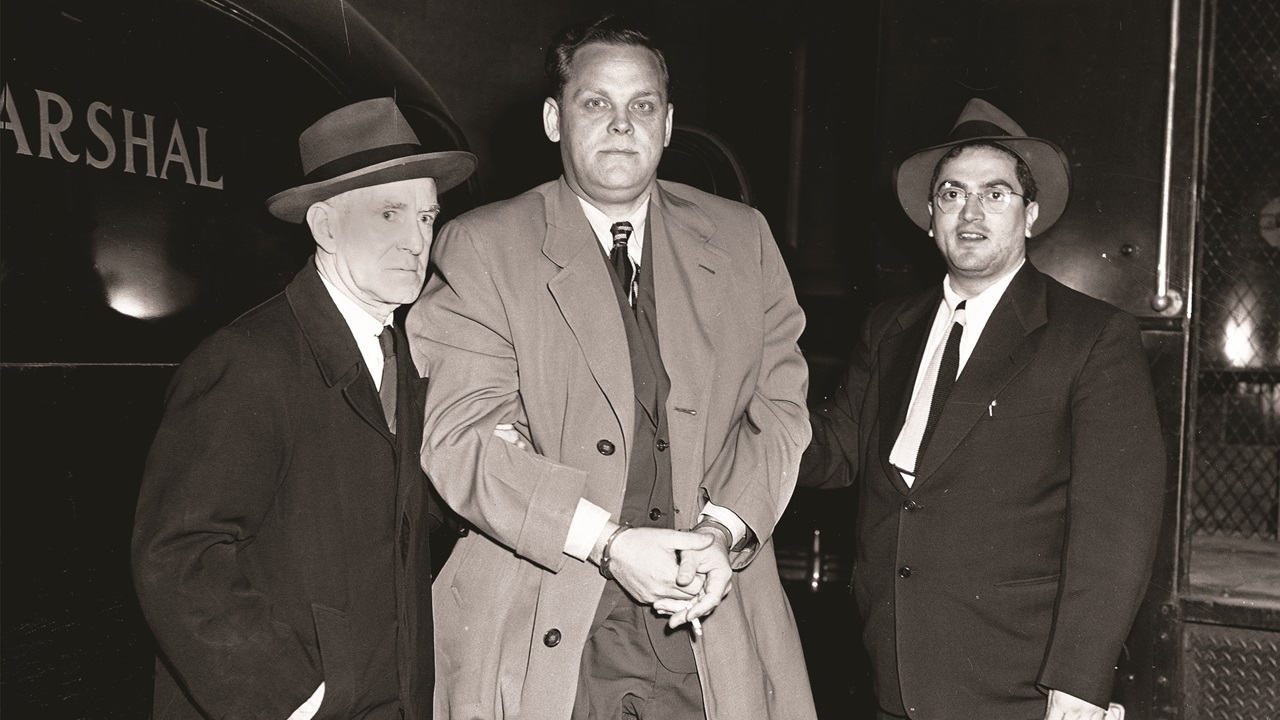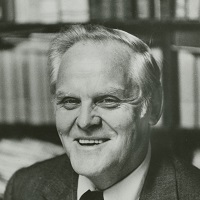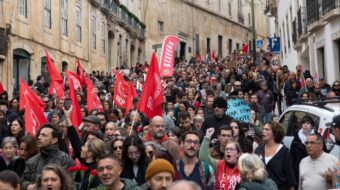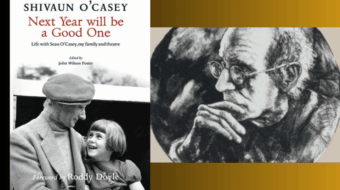
Editor’s Introduction:
The following text was written by Communist Party USA General Secretary Gus Hall in August 1975 as an introduction to Italian Communist leader Palmiro Togliatti’s book, “Lectures on Fascism,” published in English for the first time by International Publishers the following year. Togliatti gave his lectures during a 15-part course he taught at the Lenin School in Moscow in 1935, a time when the world fascist movement was rapidly growing in strength. Hall wrote his introduction 40 years later, in the aftermath of the Watergate scandal, a period also defined by right-wing reaction, racism, and plots against democracy.
Though Hall references President Richard Nixon and Watergate, contemporary readers can easily substitute Donald Trump and Project 2025. In fact, as we saw during the Jan. 6, 2021, coup attempt and as is obvious in the schemes to steal the 2024 election that are underway right now, the fascist danger in the U.S. today is probably greater than it was when Hall wrote his text.
Hall said that “anti-communism, great power chauvinism, white supremacy, racism, and anti-Semitism” were the hallmarks of fascism’s divide-and-rule strategy, and he argued that in the U.S., racism was the most dangerous tool in fascism’s arsenal.
With Trump and MAGA, we see all these and more: Kamala Harris is denounced as a Marxist, countries around the world are threatened with the military might of U.S. imperialism if they step out of line, concentration camps are proposed for left-wing dissidents, militant trade union leaders like Shawn Fain are demonized, the “great replacement theory” is peddled to mobilize white supremacist sentiment, immigrants are villainized as the alleged cause of every social problem (real or imagined), and Jewish Americans are ostracized for “hating Israel” if they don’t vote Republican. Misogyny, sexism, anti-LGBTQ hatred, and more could be added to the list of weapons that 21st century fascists rely on to bring out their base.
Behind it all are the billionaires of the ruling class, the right-wing sections of finance capital, and big tech who are crafting the agenda of a second Trump administration with their Project 2025. Just like the 1930s and ’70s, these fascists of today will happily dispense with the formalities of bourgeois democracy if the latter get in the way of their rule. Curtis Yarvin—one of J.D. Vance’s ideological teachers—admitted it when he said, “Americans need to get over their dictator phobia.”
But also just like in decades past, the fascism of today cannot overcome the contradictions and class struggle inherent to capitalism. Like then, a broad and united political and ideological struggle can undermine the appeal fascism holds among certain sections of the working class and ultimately defeat it. Unlike those times, unfortunately however, there is no powerful socialist camp to stand as a bulwark against U.S. imperialism and fascism—that means the task is up to us—the labor and people’s movements.
Read Hall’s introduction and then pick up a copy of Togliatti’s original book (an updated version is now available from International Publishers) so that you’ll be better ideologically armed for the struggles of today and tomorrow. There’s still a long road ahead in the fight to block fascism in our country, and the list of ruling class reactionaries is far bigger than just Donald Trump.
– C.J. Atkins, People’s World Managing Editor
 By publishing these lectures of Palmiro Togliatti, International Publishers is making an important contribution to the struggle against the forces of reaction and fascism. For some, this may be an interesting book from the viewpoint of history. But for the people of the United States, these lectures can be lessons of history we must study and apply.
By publishing these lectures of Palmiro Togliatti, International Publishers is making an important contribution to the struggle against the forces of reaction and fascism. For some, this may be an interesting book from the viewpoint of history. But for the people of the United States, these lectures can be lessons of history we must study and apply.
In the realm of theory and political and ideological thought, nothing can substitute for the key element of experience. The greater the body of experience one can draw on, the more perceptive, penetrating, and illuminating are the conclusions and the lessons. The thoughts are even clearer if one’s personal involvement and experiences are interwoven into the fabric of the general experience of the masses. The body of experience of the working class and people of each nation is of significance. But by itself, it is not enough from which to draw generalized theoretical, strategic, or even tactical conclusions. Conclusions become accepted lessons only when they are checked and measured against the experiences from many lands.
The drawing of generalized conclusions, and the further development of theory, is of necessity a collective process.
This fact stands out clearly and sharply in every one of Togliatti’s “lessons.” He draws on the experiences of twelve years of struggle against fascism in Italy. The “lessons” are even more vivid because he was able to draw on the experiences of his personal involvement in the struggle.
But Togliatti takes advantage of even a much broader body of experience. He was an active participant in the continuing discussions and examinations of worldwide experiences in the struggle against fascism. These discussions went on in the committees of the Communist International.
The Communist International was a center where the experiences of each country from every corner of the world became the generalized experience. By the time Togliatti delivered his lectures, Hitler’s fascism had been in power for some two years. So it is natural that he would especially use the experiences of the German people and the German Communists in their struggle against Hitler-fascism.
The people who made up the committees of the Communist International came from working-class political parties. They represented parties who based their work, their assessments, on the revolutionary science of Marxism-Leninism. So it follows that the committees of the Communist International approached all questions from the viewpoint of the working class and of Marxism-Leninism. This approach runs like a steel wire through all of Togliatti’s lectures.
Because of the nature of the challenge by monopoly capital, we in the United States cannot afford the luxury of reading these lectures as interesting history but not especially of our concern. The fact is that more than any other people the lessons from the struggle against fascism must be of our concern.
These lessons are of significance because more than any other people we in the United States face the danger of fascism as a continuing challenge. We face the danger now, and we are going to be forced to fight against fascism as long as we are dominated by the system of monopoly capitalism. Monopoly capitalism keeps fascism as one of the options open to it when the other forms of rule become obstacles to its drive for maximum profits.

But if we learn the lessons of history as explained and pinpointed by Togliatti, we can be an important factor, together with the masses in struggle, in deciding that “it will not happen here.“
The very first lesson that we must draw is that the inner laws of capitalism give rise to an anti-democratic tendency that feeds the movements toward fascism. In the period of capitalism’s crisis and decay, Togliatti speaks about “the tendency toward reactionary policies in capitalism.” When in the period of its general crisis monopoly capital cannot pursue policies of maximum corporate profits, and if democratic institutions provide even the very minimum possibilities for intervention by the people against such policies, monopoly capitalism moves to hogtie or to eliminate such structures. It moves to replace democratic structures with reactionary and military regimes. Fascism is the most brutal, devastating, developed form of such big business dictatorships.
The lectures by Comrade Togliatti provide a new dimension to the developments around Watergate because what was exposed around the Nixon administration and Watergate was a calculated, conspiratorial process in the creation of the structure which could have led to and served as a fascist structure. This process did not start with Nixon. The framework was quite well designed. The political, military, and economic power was slowly being concentrated into the exclusive Executive Branch, an Executive Branch that was beyond the reach of anyone except of course the monarchs of big business. Slowly, Congress and even the President’s Cabinet were bypassed. The FBI and the CIA have become a police state apparatus, operating on the basis of pages from the handbook of German and Italian fascism. The Nixon administration prepared executive orders for use in mass roundups of all who resisted the pro-big business reactionary policies. Not even Hitler and Mussolini had available to them such massive computerized lists of names and personal histories of anyone who had ever uttered a word of protest on any question as were available to the Nixon administration. These lists are available to the Ford administration to this very day. Thus, the “tendency toward reaction” was laying the basis for fascism.
The lessons pointed out by Togliatti are of such vital concern to us because while the Watergate exposés and the forced Nixon resignation dealt a blow to these reactionary forces they did not put an end to the “inherent reactionary tendency” of monopoly capitalism. The “reactionary tendency” is very much alive. Fascism always operates under false and demagogic colors. It especially tries to cover up the fact that it is “the open dictatorship of the most reactionary section of monopoly capital.”
Looking back, the discussions and debates about the definition of fascism during the 1930s now seem abstract mainly because the basic nature of fascism is now well known. The discussions in the Communist circles were more of a debate with erroneous concepts in other left-liberal circles, most of them reflecting the influence of the demagogy and the coverup falsehoods spread by fascism.
It was necessary to expose the falsehood that fascism was “a middle-class, petty bourgeois movement.” It was necessary to state the fact that the petty bourgeois sector was and remains fascism’s mass base, but that it is not the political essence of fascism.
The Trotskyites put forth their attempt at confusing the issues, covering up the class roots of fascism by calling fascism a “Bonapartist movement.” The right-wing socialists kept seeking and projecting some positive features of fascism.
It was necessary to define fascism as the open brutal dictatorship of the most reactionary sections of the top circles of monopoly capital, because only then was it possible to pinpoint and direct a struggle against the real enemy. Only then was it possible to mobilize the broadest movement against fascism.

During the years of Togliatti’s lectures, the Socialist Party in the United States, under the influence of the Trotskyites who had infiltrated and largely captured its leadership, refused to participate in any anti-fascist movement. The leadership disguised its refusal through left demagogy that the task at hand was not a broad unity against fascism but rather that the struggle was “class against class.” As was to be expected, the ruling class did not mind such rhetoric, especially because such left demagogy was a factor in dividing the forces that had the potential to stop the efforts of monopoly capital in establishing their open dictatorship. “Class against class” was not a policy in the interest of the working class, and it was not harmful to the interests of the capitalist class. It was empty rhetoric. But it was divisive.
It was the correct Communist assessment and definition of fascism as “the open dictatorship of the most reactionary sections of monopoly capital” that provided the base for the winning anti-fascist coalition. As a result of continuous examinations, and then collective discussions, a fully rounded-out and scientifically correct definition emerged. In his historic report to the Seventh World Congress of the Communist International in 1935, Georgi Dimitrov gave the following definition of fascism as “the terroristic dictatorship of the most reactionary, most chauvinistic and most imperialistic elements of finance capital.”
Possibly the most important lesson of history for us in the United States is to develop an awareness of the factors that are present in our midst today that can become the base for a fascist development.
More important than the existence of some small fascist sects is the political and ideological preparation of the mass base for fascism that is going on now. From the lessons of Italy and Germany, it is clear that the ideological and political atmosphere is prepared by the general ideological forces of capitalism. The “tendency toward reaction” is reflected in these ideological preparations for fascism.
“We, the middle class, are being taxed and squeezed by big government, big labor, and big business.” This sounds to middle-class ears like a good slogan put forth by ultra-right forces such as the racist Alabama governor, George Wallace, the ultra-reactionary former California governor, Ronald Reagan, and others. The words “big business” are thrown in as a sop. They are a coverup for their efforts to create an atmosphere against the working class and the trade unions. By “big government” they mean any institution over which the public has any influence. As was the case in Italy, U.S. fascism would be the open dictatorship of big business.
“Divide and rule” is the most basic element of power when a minority rules over and exploits the majority. It has been a feature of capitalist rule from its inception. Throughout history, its applications and forms have varied, depending on the specific circumstances. In the major capitalist countries, the main instruments of “divide and rule” are anti-communism, great power chauvinism, white supremacy, racism, and anti-Semitism. In the political and ideological sphere, the instrument has been and is anti-communism. Fascism takes these ideological instruments of capitalism and develops them into its major weapons. German-Hitler-fascism made anti-communism and anti-Semitism its main political and ideological weapons. Italian fascism used anti-communism and racism as its main instruments. The brutal attack on the villages and cities of Ethiopia by Italian bombers was accompanied by the most violent, despicable racist campaign.
We in the United States must see racism as the “divide and rule” ideological poison, as it is used by big business to divide and rule today. But we must also see it as a most dangerous substance that fascism feeds upon. We must draw the basic lesson that in the United States if we are serious about blocking the path of fascism, we must fight to burn out racism.
The gangs attacking the homes where Black families live in Boston are racist thugs. But they are also the embryo of a fascist movement. In fact, they have already moved from attacking the homes of Black Americans to attacking trade unions.
In this sense, we must also not be misled by the fact that some elements of anti-Semitism are “out of sight.” Anti-Semitism remains a live virus on the American scene. To fight the fascist danger is to fight against anti-Semitism.
With the growth of the fascist danger, there will be an increase in the campaigns of anti-communism, racism, great power chauvinism, and anti-Semitism.
Capitalism has always tried to cover up the fact that it exists because it exploits the working class. Fascism takes this cover a step further. Before fascism, defenders of capitalism speak about “class collaboration.” When fascism is in power, they speak about “eliminating the class contradiction.” This is the basis of its propaganda for a corporate state. This of course is demagogy and nonsense because as long as there is capitalism, there is a class contradiction and the class struggle. So, in the framework of the danger of fascism, the class collaborationist policies of Meany and the AFL-CIO leadership take on an additional dimension. Thus, to fight against the danger of fascism today means to struggle against the policies of class collaboration. There is a very basic lesson in Togliatti’s lectures even for the class collaborationist trade union leaders. Once fascism becomes established, it destroys all trade unions, including the ones with policies of class collaboration. In their place, they set up their own fascist labor-front organizations.
In studying the lessons of the struggle against fascism in Germany and Italy, it is necessary to see the longer-range connotations of the appearance of many new “solutions” to the problems of capitalism in the United States. “Planning” has replaced “rugged individualism” as a concept. The proposals are “planning” based on class collaboration. It is “economic planning” that is in the service of monopoly capital. It is “planning” of exploitation, of greater profits. Fascism also makes a big pitch about “planning,” and it is also “planning’ in the best interest of big business.
In view of the negative role of social democracy in Portugal, India, and many other countries, Togliatti’s discussion of the policies pursued by the leadership of the Socialist Party before and during fascism takes on added importance. In Italy as well as in Germany, social democracy was a factor in preparing the advent of fascism to power. It was involved in the preparations. Because of this, it is unfortunate that the “transcriber” of Togliatti’s notes deleted some sections in which Togliatti discussed the role of social democracy.
Fascism does not overcome the contradictions of capitalism. For periods, it smothers them. But in one way or another they continue to surface, thus opening up new possibilities for struggles against fascism. The contradictions open up the possibility of struggle, but its defeat can come only as a result of organized mass struggle.
“In conclusion,” Togliatti stated, “one must not believe that the masses—regimented, organized, and influenced by the Fascists—one fine day will move away from fascism spontaneously, as a matter of course, and come over to us, to the proletarian revolution. We must seek these masses out and organize their changeover to our side.”
There are a number of formulations that Togliatti set forth about the basic policies in the struggle against fascism. He places great emphasis on “the correct position of principle,” a correct estimation of the relationship of forces, and ‘correct solutions of the tactical problems.” The emphasis on the “correct position of principle” as a basis for “correct solutions of tactical problems” is a warning against slipping into positions of opportunism.

Based on the accumulation of evidence from the wealth of world experience, Togliatti draws the conclusions that:
— Fascism is a danger in the capitalist countries, but it is not an inevitable stage of development;
— Fascism cannot resolve the problems and contradictions of capitalism. Thus, the basic class contradiction and the class struggle will continue;
— When fascism is in power, even under the most extreme conditions, it is possible to develop a mass movement and struggle to defeat fascism;
— Fascism does not collapse from its own internal contradictions, but they can be used to defeat it.
In the lectures, Togliatti reflected on the experiences and the conclusions drawn by the committees of the Communist International up to 1934. In 1935, the Communist International convened the historic Seventh World Congress. In the main report to that Congress, the heroic Communist leader Dimitrov, who as a prisoner had challenged Hitler-fascism, brought all of the experiences and conclusions up-to-date. From the Seventh Congress of the Communist International, the call went out: “Unity Against Fascism.”
The lectures of Togliatti were an important feature of the collective preparations for the Seventh World Congress. Because of its work, the Communist movement the world over was able to fulfill its vanguard role in the struggle against fascism. It was the Communist Parties and their policies of anti-fascist unity that created the mass base for the anti-fascism that defeated the fascist challenge.
It was not an accident of history that the lectures were delivered in the Soviet Union. The Soviet Union, a revolutionary working-class socialist state, was the central force blocking the path of fascism. It was not an accident of history that the Soviet Union was the main force in militarily defeating the forces of fascism in the Second World War. It is not an accident of history that the Soviet Union and the other socialist states are today the main obstacle to the path of world imperialism and the main bastion in the struggle against fascism.
The lectures in this book are not only lessons of history. They are lessons in the use of Marxism-Leninism. They are lessons in the working class approach to all questions.
We hope you appreciated this article. At People’s World, we believe news and information should be free and accessible to all, but we need your help. Our journalism is free of corporate influence and paywalls because we are totally reader-supported. Only you, our readers and supporters, make this possible. If you enjoy reading People’s World and the stories we bring you, please support our work by donating or becoming a monthly sustainer today. Thank you!










